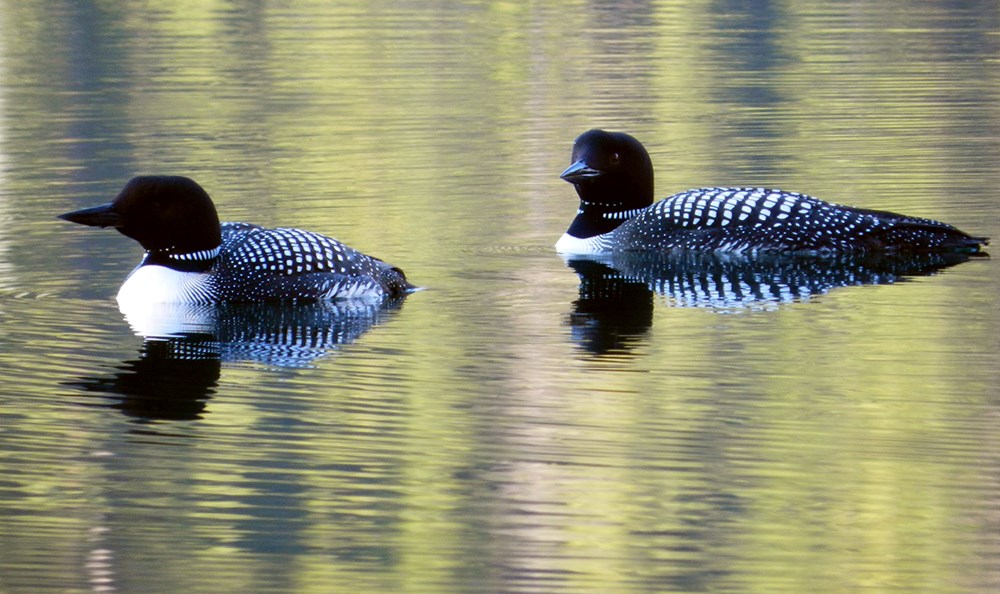Last updated: October 14, 2024
Article
Common Loon Resource Brief
Background Information

NPS/E. Peterson
Threats
Once seen as far south as places like Colorado, Illinois, and northern California, habitat loss has confined the common loon’s breeding habitat to far northern areas of the United States. In Montana, the common loon is listed as a Species of Concern and monitoring efforts are ongoing throughout the state. The biggest threat to loons is human disturbance. Shoreline development, recreation and watercraft use, and human-caused water level fluctuations can cause the loss of adequate nesting habitat or even of nests and eggs themselves. Other threats include ingested lead from fishing lures, discarded fishing line, which can entangle and kill loons, and mercury exposure, which can lead to reproductive failure and have effects on chick behavior and development.
The common loon, with its mournful wail, conjures up images of wilderness, solitude, and remote northern lakes. Common loons are found on pristine freshwater lakes throughout the Crown of the Continent Ecosystem during the breeding season (early spring through fall), migrating to coastal areas for the winter. They are large, relatively long-lived birds (living 25–30 years) with unique adaptations that allow them to be excellent divers and swimmers.
Unlike most birds, they have dense bones (rather than hollow), heavy bodies (8–12 lbs.), and comparatively small wings for their body size. These characteristics make loons adept at diving underwater when hunting their main prey of fish. The loon’s ability to quickly blow air out of its lungs and compress air out of its feathers helps it dive instantly when in search of food. A loon can also use these tactics to submerge its body below the water surface with only its head above water, making it less detectable.
Loons are agile swimmers. Large, webbed feet and legs set far back on their bodies allow these birds to powerfully propel themselves underwater as well as in takeoff. In order to achieve flight, they run on top of the water, flapping their wings to gain enough momentum for liftoff. These traits do, however, make it difficult for loons to walk on land and make takeoff virtually impossible in a small body of water. Loons are only found on land when mating or nesting, or if sick or injured.
Status and Trends
Listed as a Species of Concern by the state of Montana, Montana’s loon population is considered to be at risk and requires ongoing management to ensure population health. Besides threats from human activities, loons have a set of biological limitations that make them more vulnerable to change.
Common loons have specific habitat requirements—lakes over five acres in size, clear water, little disturbance, and a good supply of fish and/or aquatic invertebrates. They also have a low recruitment rate, only producing up to two chicks per mating pair each year, and are slow to mature—the average first year of successful breeding is seven years old.
Current estimates show that Glacier National Park harbors roughly 20–25% of the breeding population of common loons in the state of Montana. Despite comprising such a large portion of the state’s breeding loons, only 4–7 chicks are fledged each year in the park. In order to better understand population trends and chick survival, Glacier began participating in Montana Loon Day (an annual statewide loon count that takes place in mid-July) in 1988. Park managers soon realized that more intensive monitoring was needed to track Glacier’s loon population.
Volunteer citizen scientists and park staff have been trained since 2005 to monitor 45 priority loon lakes at least three times throughout the breeding season. This season-long monitoring effort provides more accurate data and will help determine common loon population trends and factors affecting their survival. As of 2018, data from the last 13 years shows an average of 44 adult loons and 8 chicks per year in Glacier National Park.

NPS Graphic
Management Strategy
In 2005, park biologists and Crown of the Continent Research Learning Center staff created the Common Loon Citizen Science Project, which uses trained volunteers and staff to gather season-long data on common loons throughout Glacier National Park.
The main goal of the project is to gain a better estimate of Glacier’s loon population and to identify factors affecting nesting success. Using a large volunteer workforce increases coverage of all 45 of the park’s priority loon lakes throughout the nesting season. This improves reliability of loon population counts, breeding pair numbers, and chick survival. The data collected helps determine threats to loon population health and gives park managers the information needed to make educated management decisions.
Resources for More Information
Glacier National Park Staff
- Jami Belt, Biologist, Citizen Science Program
- Lisa Bate, Wildlife Biologist
Documents and web sites
- Montana Fish, Wildife & Parks’ Conservation Plan for the Common Loon — http://fwp.mt.gov/fishAndWildlife/management/commonLoon
- Glacier Common Loon Citizen Science Project — www.nps.gov/rlc/crown/common-loon-citizen-science-project.htm
- NatureServe Explorer: An Online Encyclopedia for Life – http://www.natureserve.org/explorer
The Crown of the Continent Research Learning Center
Phone: 406-888-7894; Email: glac_citizen_science@nps.gov
Website: www.nps.gov/rlc/crown
